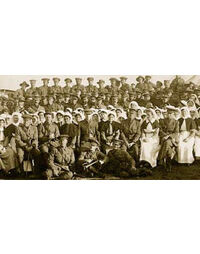What it was like for nurses at Gallipoli
ANZAC Day is usually the story told of the brave men and women who fought at war. There is little documentation of what it was like for nurses treating the soldiers during these horrendous times.
It has been well documented that Gallipoli was one of the worst fighting fronts in World War 1.
Right from the landings on 25 April 1915, nurses cared for hundreds of casualties in the hospital and transport ships anchored off-shore. The wounded came in an endless stream, day and night, some barely able to walk, others on stretchers, shivering or unconscious through loss of blood. Medical supplies were limited and there was a desperate lack of fresh water. Despite the constant threat of Turkish shelling or torpedoes, the exhausted nurses cleaned, bandaged, warmed, and comforted their patients, many of whom had ghastly wounds or were suffering from the effects of gangrene and disease.
On the hospital ships off Gallipoli, Australian nurses came face to face for the first time with the reality of the wounded. It made some of them confront the limitations of their nursing skills and the notion of the glory of war. Working on the hospital ship Sicilia Sister Lydia King confided to her diary:
I shall never forget the awful feeling of hopelessness on night duty. It was dreadful. I had two wards downstairs, each over 100 patients and then I had small wards upstairs Ñ altogether about 250 patients to look after, and one orderly and one Indian sweeper. Shall not describe their wounds, they were too awful. One loses sight of all the honour and the glory in the work we are doing.
[Lydia King, in Goodman, Our War Nurses, p.39]
For the next nine months, soldiers were ferried to hospitals on the nearby Greek islands of Imbros and Lemnos, or transferred to Malta, Egypt, and Britain. Wards on the lower decks were crowded and poorly ventilated, and even simple nursing tasks were made difficult by the movement of the ship. Seasickness struck down nurses and patients alike.
These were challenging locations for the women. With little preparation, they were expected to manage large hospitals, overseeing nonÐEnglish speaking staff who had very different customs.
Back in Eqypt, 1st Australian General Hospital (1AGH), established in the grand Heliopolis Palace Hotel in Cairo, or to 2AGH in Mena House, a former royal hunting lodge. With the rapid influx of patients from Gallipoli in April 1915, the facilities were soon overcrowded, and equipment and supplies inadequate. Nursing staff worked around the clock.
1AGH took over a nearby amusement park, turning the ticket office into an operating theatre and the skating rink, scenic railway, and skeleton house into wards. Within three months it was operating as a 1,500-bed hospital.
Some of the badly wounded were returned to Australia on hospital ships, accompanied by nurses.
More than 3,000 Australian civilian nurses volunteered for active service during the First World War. Although there is not a lot of documentation of their efforts, their hard work, caring nature and dedication was well regarded.





